"After your death you will be what you were before your birth." -Arthur Schopenhauer
If only every star's death could be as glorious as a supernova, rocketing anywhere from thousands to millions of Earth-masses out of a star and into interstellar space. When we get one in our galaxy, like we do every few hundred years, the view from Earth can be spectacular.
The Crab Nebula, above, sprung from a supernova nearly a thousand years ago, in 1054. And while that supernova, and a handful of others since, have been visible from Earth with nothing more than the naked eye, we haven't had that pleasure since 1604. The remnant of that supernova, of course, is still visible today, although it looks no more impressive in visible light than the very end of a fireworks display.
While every astronomer would love to have the chance to see a supernova in our own galaxy, these aren't the sorts of things we can control. Instead, we have to be content to see what the Universe gives us to look at. We came close a generation ago, in 1987, when a supernova went off in the Large Magellanic Cloud, a satellite galaxy just 160,000 light years away. Under ideally dark skies, the supernova was just barely visible to the unaided eye in the Southern Hemisphere.
For a generation since then, we haven't had a supernova occur anywhere near as close as that one. Which is too bad, because our telescope technology and coverage, today, is the greatest it's ever been.
But last month, on August 24th, the closest supernova since SN1987a went off in our neighbor galaxy -- the Pinwheel Galaxy -- just 21 million light years away.
Despite the deceptive image above, the Pinwheel Galaxy is actually incredibly difficult to observe without extraordinarily dark skies, despite its close proximity to us. The reason? As far as spiral galaxies go, the Pinwheel, intrinsically, has an extremely low surface brightness.
You should consider yourself incredibly lucky if you can get a view like this of the Pinwheel Galaxy.
The supernova that went off on the 24th of August -- PTF11kly -- is reaching peak brightness this weekend (between the 9th and the 12th of September), and has been photographed by a few great people, including Rick Johnson, below, with a 14" telescope,
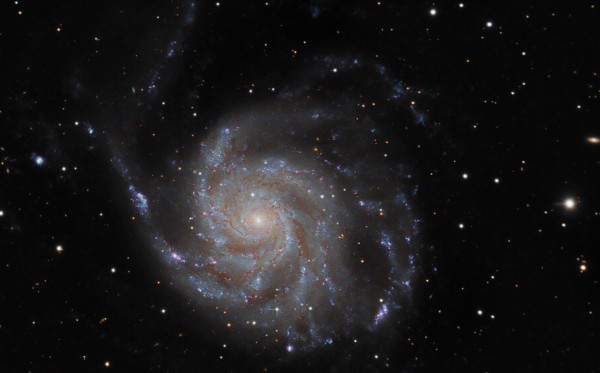
and this image, retrieved from the Rose City Astronomers:
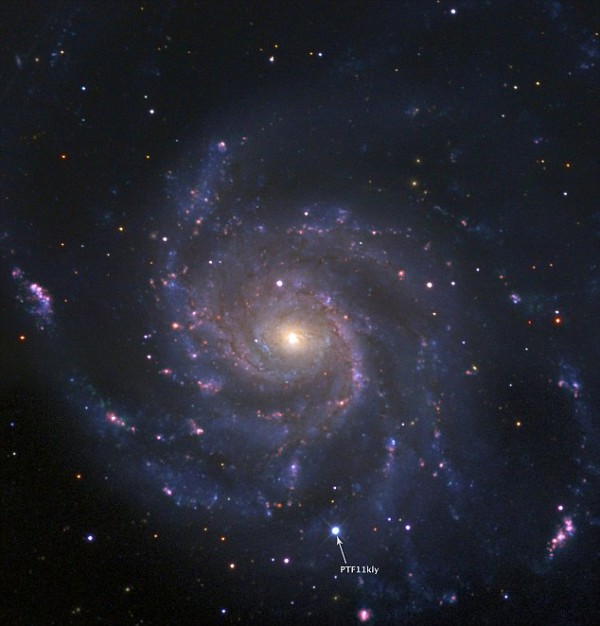
There are all sorts of sources telling you to go out and view it, including this video which is going viral.
The Moon is out! Even more maddening, the Moon is out in the early part of the night, when the Pinwheel galaxy is best viewed. But contrary to what everyone else is telling you, here's some good practical advice: wait a week.
Yes, that's right, wait. Supernovae take a long time to fade away, and a week really won't make much difference in terms of how bright the supernova itself appears. But the benefits are huge: a week from now (from about the 16th to the 19th), the early part of the night (between 8-10 PM) will have much less light pollution, because the Moon will not yet have risen. The Big Dipper will still be high in the sky, and if you can get yourself some dark skies, you should be able to find the Pinwheel Galaxy.
I've told you how once before, but due to its difficulty (unless you've got an automated scope), here's how in much greater detail.
Start by finding the Big Dipper, above. These seven bright stars make up one of the best known constellations/asterisms in the sky, and are instantly recognizable to even the most casual of northern hemisphere skywatchers.
I've included the location of the Pinwheel Galaxy with a tiny orange circle, but getting there takes a bit of finesse. Here's the easiest way to do it, and here's what you're looking for.
The end of the handle of the Dipper is named Alkaid, the one next to it is the double star, Mizar/Alcor, easily resolvable with even a low power telescope (and by some of you with your naked eye). Set up your telescope to center on the Mizar/Alcor pair.
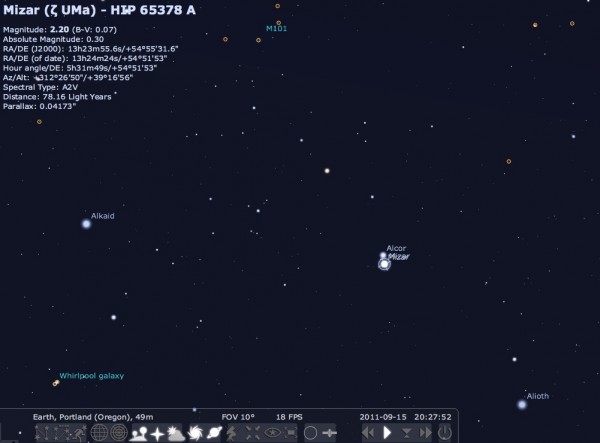
This shows you what you might see through a large field-of-view finderscope. (Without the labels, of course.) Mizar is the brighter of the two; Alcor is slightly dimmer but is still one of the brighter stars in the sky. If you draw an imaginary line from Mizar through Alcor and keep going, you'll come to a relatively bright, bluish star before too long. Although barely at the limit of what's visible to the naked eye, it's easily visible through even binoculars. Center on that star, and then look towards the left.
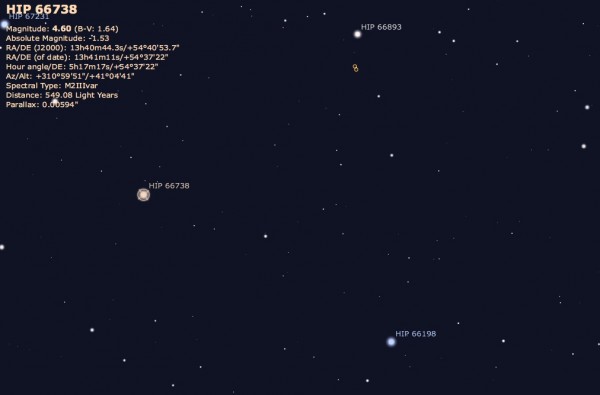
A brighter, orange star should be apparent, about the same distance from the blue one you're at now as it was from Mizar/Alcor. Center on that orange one (if you can't see color, it's simply the next bright one up and to the left), and look -- again -- up and to the left.
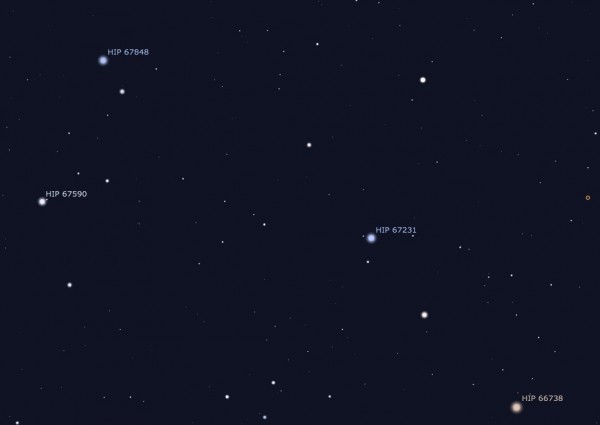
There should be two more relatively bright, bluer stars in a row, again about the same distance away as the last two jumps you made. Take those two jumps, to the second blue star, and then, instead of continuing up and to the left, look straight up, away from the handle of the Big Dipper.
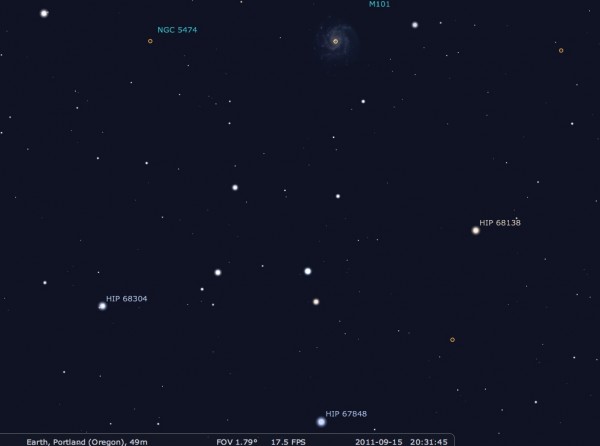
The whole point of waiting a week to do this is that, with the Moon out, the sky will be too bright for you to make out this galaxy! But with the Moon still below the horizon and light pollution at a minimum, you should be able to see -- however faintly -- the Pinwheel Galaxy!
If you've got good viewing conditions and good enough equipment, you should be able to see something like this.
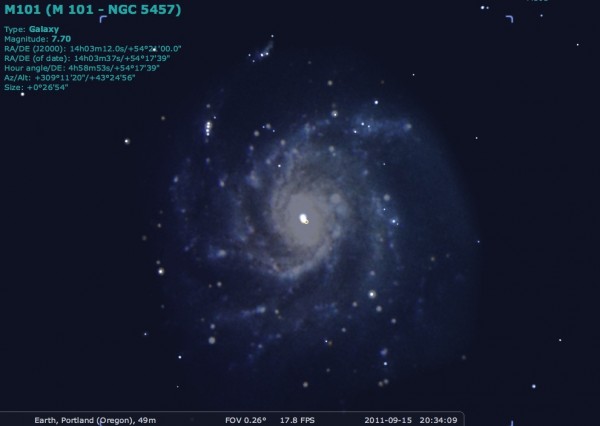
Now, this is what the Pinwheel Galaxy looked like without the supernova in it!
But there will be one extra bright "spot" on the galaxy, where the supernova is. Where should you look? Well, if you followed my directions there, you should have the same orientation through your eyepiece as I have in the image above.
So look here:
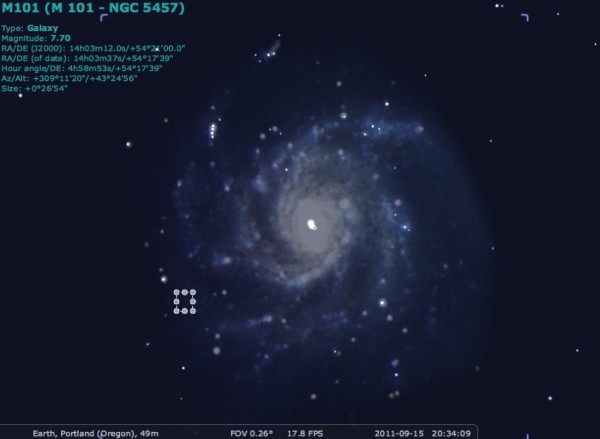
If this patch of the galaxy has a (relatively) bright, compact light source in it, congratulations! You've just found yourself a supernova!
So be patient and bide your time; I'd hate for you to look with a nearly full Moon shining and get frustratingly disappointed. Wait a week. The supernova will fade a little, but the rewards will still be there for you. And no matter what you're doing, enjoy the night sky, and the fact that the light from a single exploded star traveled for 21 million years, all the way to our eyes!
- Log in to post comments

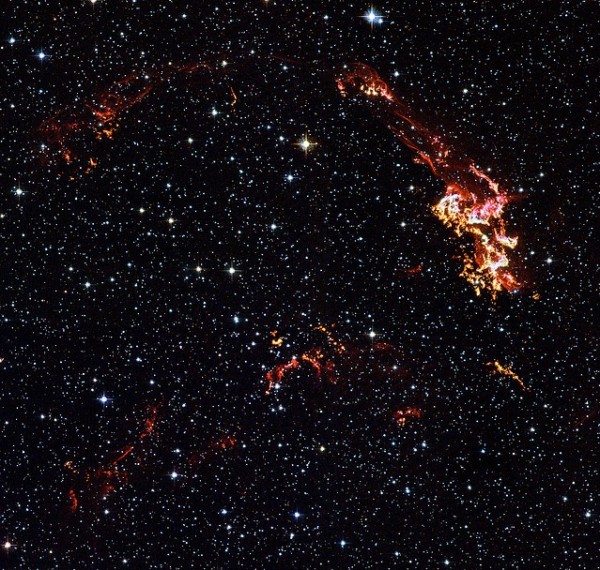
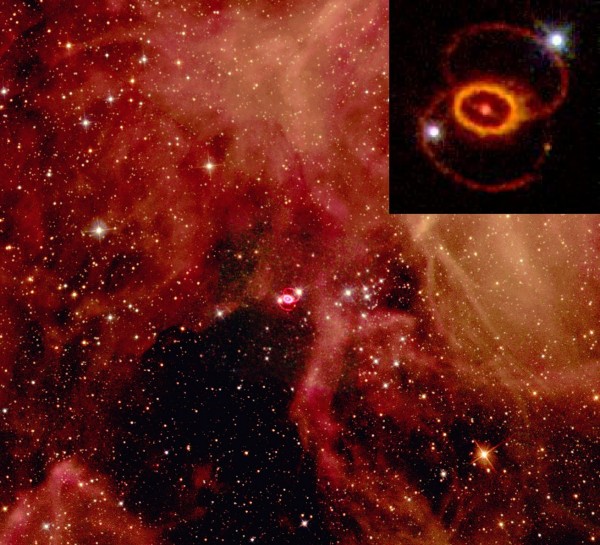
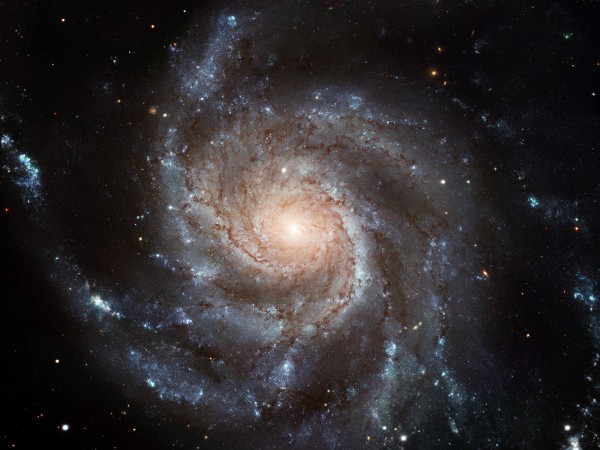
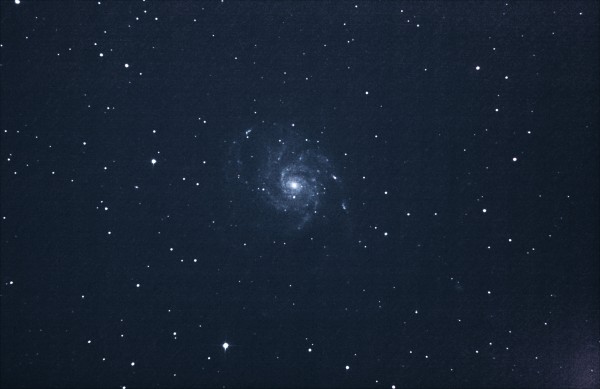
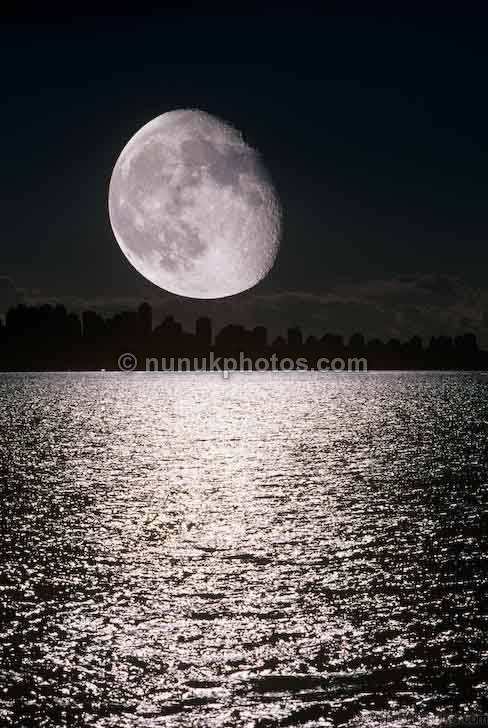
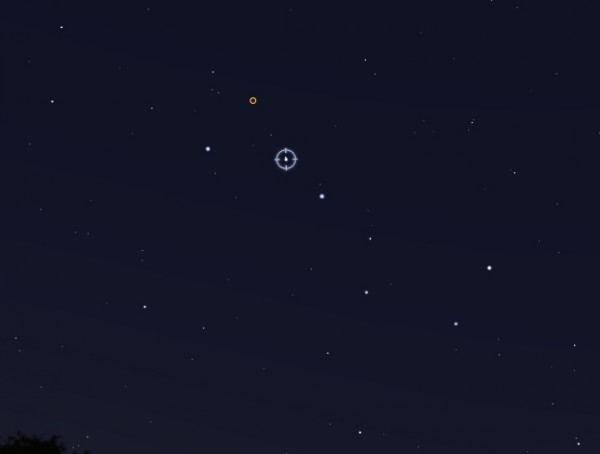
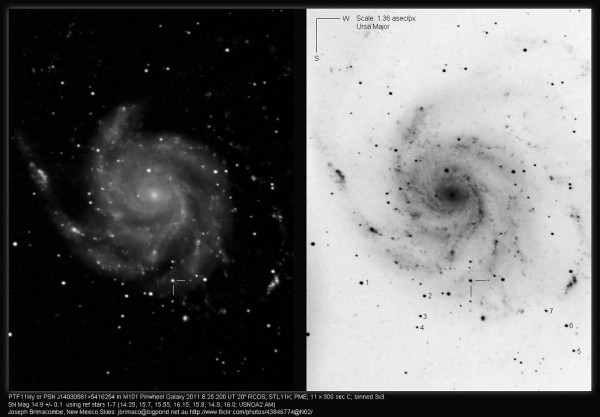
Awesome images and tips, thanks for the 'deep' background. Does the energy or dust from super novae ever affect our solar system or planet (thinking of large solar flares) and if so, in what way? Can we differentiate those affects from other deep space energy sources?
There might be thousands of "ticking time bombs" even in our Milky Way, waiting to go off as a supernova:
http://www.cfa.harvard.edu/news/2011/pr201123.html
I am an amateur star gazer, and while searching for the supernova, i noticed a very bright star in the north east of the sky (more east than north east). I have been watching stars for about 20 years and have never seen a star like this....it seems more like a solid mass, like a moon, about 10 times the size of a normal star and wasnt twinkling but was solid, and extrmely white and bright, almost making out a shape, but not able to keep binoculars still enough before clouds encroached and i lost the shape. Please could you tell me what this may be and if anyone else has seen it, many thanks :)
Big deal? Aren't we seeing the supernova late by 21 million years? (Just Kidding :-)
I always have trouble coming to terms with looking at stars and seeing the ancient past. Even a photograph of me standing with stars in the background is a captured conflict of time, knowing the semantical 'simultaneous existence' of me and the stars is impossible. The thought that constituent stars of many of the celestial asterisms never existed at the same time, makes our composited view so unreal. Had nature relaxed the speed limit for light and made it instantaneous, I wonder how the sky would look now.
Amy
The energy is the electromagnetic radiation we're seeing, no different from any other star. Dust doesn't move very fast (a few thousand km/s) nor very far from where it's formed. Solar flares are due to the magnetic fields of the Sun, and the effect of those magnetic fields don't stretch very far from the star.
Now, if a supernova were to explode very close to us (maybe 50pc) the cosmic rays from that supernova would definitely affect the planet, possibly destroying the ozone layer etc. But much further away than that, a supernova wouldn't affect us more than any other bright lightsource in the sky.
Amazing video and photos! Absolutely beautiful!!! Space never ceases to amazing us, and it's complexity is just fabulous for study!
This from the Wiki entry on 'nova'
A nova (plural novae) is a cataclysmic nuclear explosion caused by the accretion of hydrogen on to the surface of a white dwarf star, which ignites and starts nuclear fusion in a runaway manner. Novae are not to be confused with supernovae or luminous red novae.
I thought '.....cataclysmic nuclear explosion caused by the accretion of hydrogen on to the surface of a white dwarf star, which ignites and starts nuclear fusion in a runaway manner....' was what happened to the star in the Pinwheel Galaxy.
Could somebody put me out of my misery?
killinchy,
In a nova, as quoted, the runaway reaction and subsequent expulsion of material happens only on the surface of the white dwarf. A supernova (Type Ia) is the collapse of the white dwarf itself, due to mass increase beyond 1.4 solar masses, and subsequent explosion of the whole star.
killinchy, the definition of what is going on to get a supernova changes as we understand solar physics more.
Supernovae initiate secondary fusion that is endothermic (removes energy from the systemic temperature) and this happens in a post-Carbon atmosphere of a larger sun.
The reason for this is that as you get higher and higher in the fusion fuel atomic weight, the rate of energy production with increased temperature increases (IIRC, H2 fusion goes as T^14, C2 fusion goes as T^20). This means that the photon pressure of this radiation product increases hugely and a small star can't keep the atmosphere on when Carbon is being fused in the star's interior.
The collapse of the core of a heavy star to the neutron star stage triggers a pressure wave in the atmosphere that wasn't undergoing fusion and is rich in carbon which will happily fuse rapidly if you can have pockets of extremely high temperature and pressure kept up.
In a nova, the pressure in the atmosphere isn't enough to get much in the way of fusion in the carbon rich atmosphere, and so only the lighter elements below uranium and above carbon get formed and that in only small amounts: the pockets of fusion can't last long enough to get heavier-than-carbon fusion products to fuse through many generations and the generation of elements above iron remove the thermal energy required to maintain their production.
This information is based on 20 year old knowledge and the bits I've been able to keep up on with the internet.
@Sofia and Wow
Thank you both. I'm not in misery any more
@killinchy @sofia @wow, here are the details.